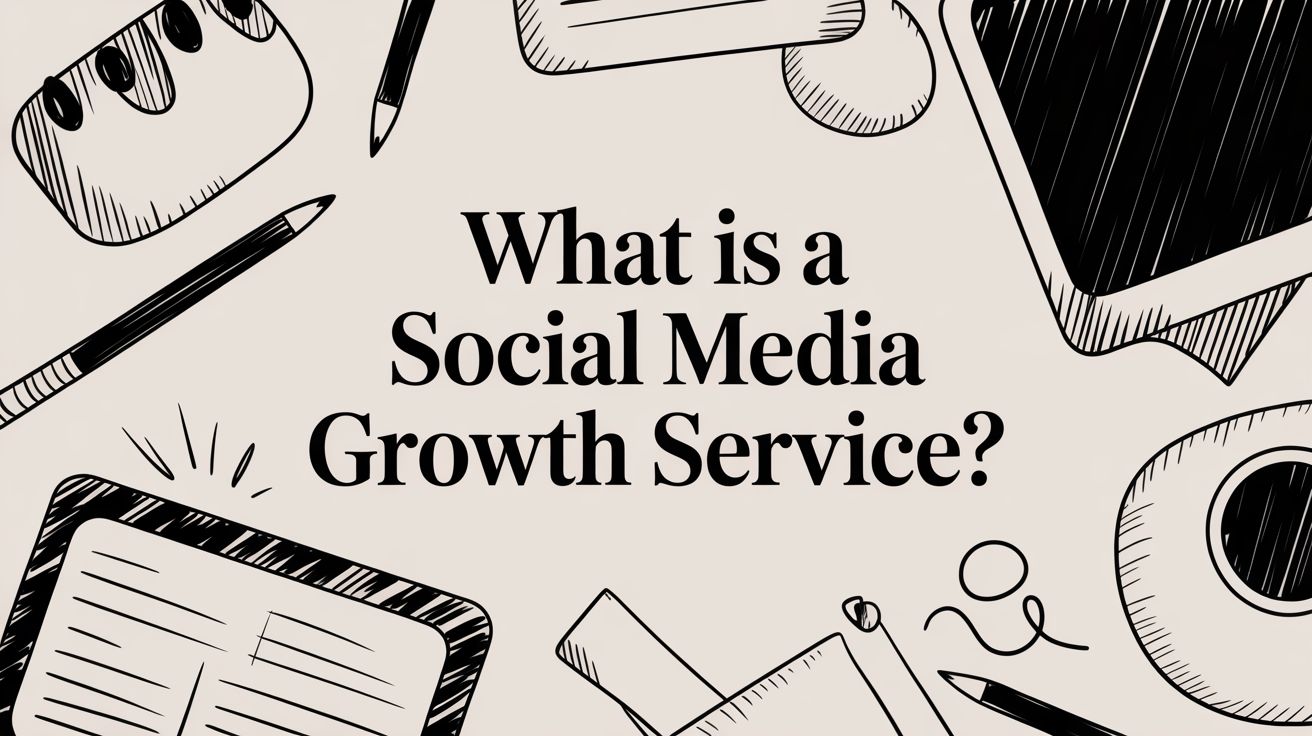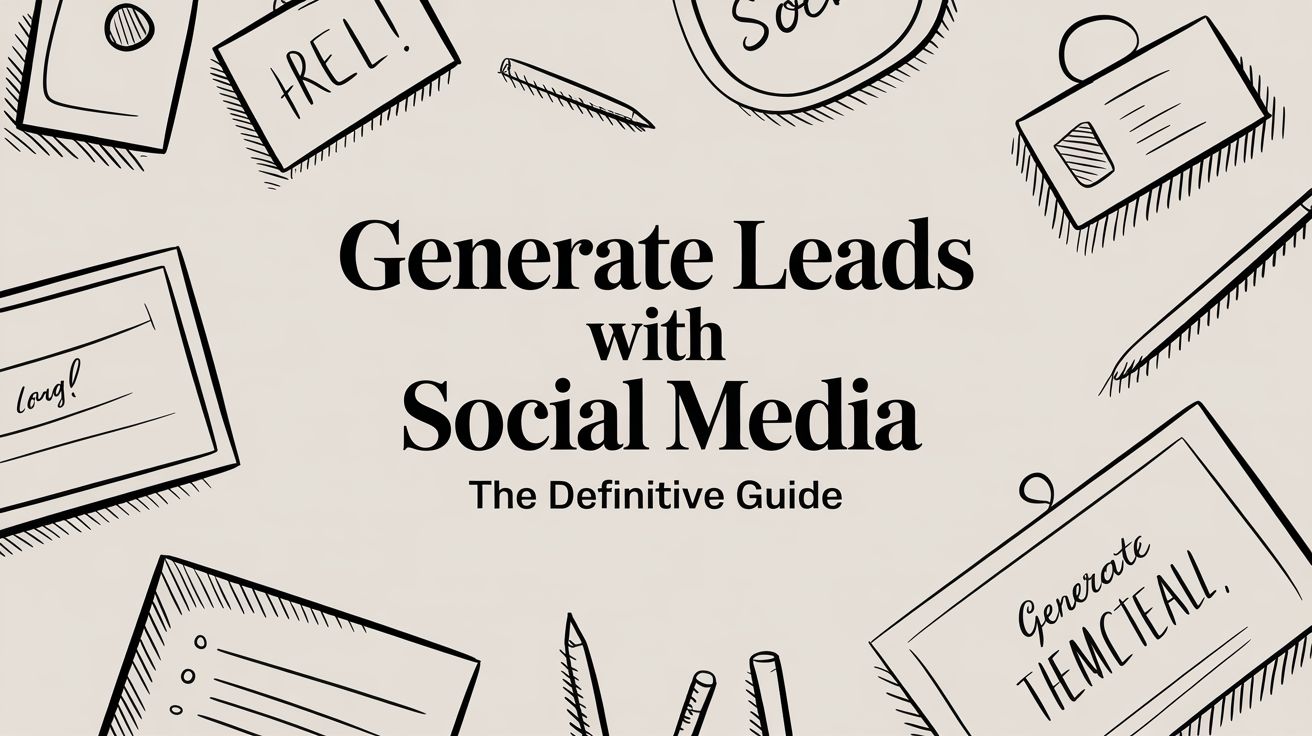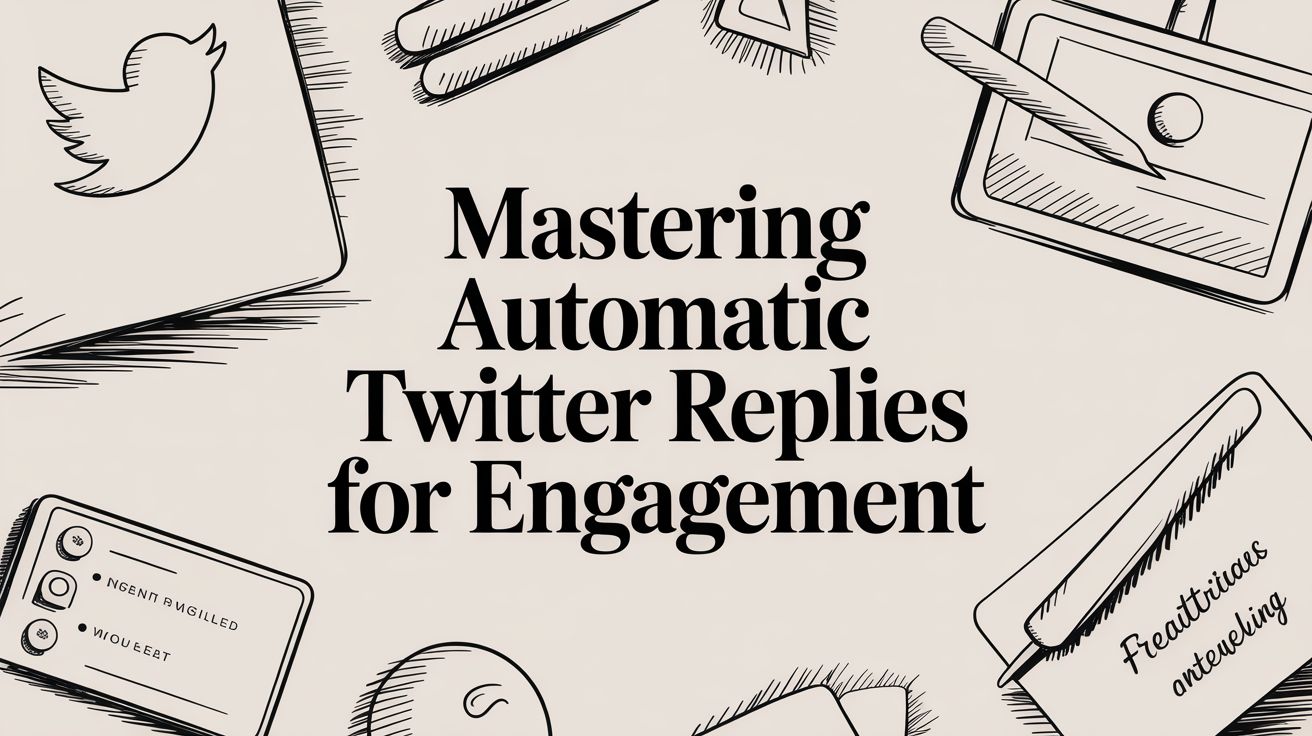Think of a social media growth service as a dedicated partner—or a specialized tool—that helps you grow your follower count and boost engagement on platforms like Instagram, X (formerly Twitter), or LinkedIn. It’s like hiring a PR team for your social profiles; their job is to get your brand in front of the right people, saving you time while building crucial social proof.
But here’s the catch: the quality and methods of these services vary wildly. You've got everything from legitimate, hands-on agencies to sketchy, bot-driven tools that can do more harm than good.
Understanding Your Options for Growth

Trying to grow a social media presence from scratch can feel like shouting into a void. For any SaaS founder, marketer, or agency, the challenge is real. After all, you're competing for attention among a massive global audience. By 2025, an estimated 5.41 billion people will be active on social media—a number that has more than doubled in just ten years. You can dig into more of these stats about explosive user growth over at Backlinko.com.
This is exactly why growth services exist. They promise a faster path to visibility in an incredibly crowded space.
At their best, these services handle the tedious, repetitive tasks involved in audience building. Instead of you spending hours manually finding relevant accounts to follow or posts to interact with, they do it for you, but on a much larger scale. This frees you up to focus on what really matters: creating killer content.
The Two Sides of the Coin: Organic vs. Automated
The methods these services use to get you followers couldn't be more different, and picking the wrong one can be a disaster for your brand. The industry is essentially split into two camps.
Organic, Human-Powered Services
These are the good guys. Think of them as an extension of your marketing team. Real people log in to your account to perform targeted outreach, leave genuine comments, and start meaningful conversations. It’s a slow-and-steady approach, but it’s focused on building a legitimate community of followers who actually care about what you have to say.
Automated Bot Services
This is the risky, cheaper alternative. These services use software—bots—to perform thousands of actions a day, like mass-following accounts, auto-liking posts based on hashtags, and spamming generic DMs. Sure, your follower count might shoot up overnight, but it’s often a hollow victory. You end up with fake accounts, ghost followers, and you risk getting penalized or even banned by the platform.
To make the difference crystal clear, let's break it down.
Organic Growth vs Automated Services at a Glance
This table gives you a quick snapshot of how these two approaches stack up against each other. It covers their methods, the kind of results you can expect, and the risks involved.
| Attribute | Organic Growth Service | Automated Bot Service |
|---|---|---|
| Method | Manual outreach by real people | High-volume actions by software bots |
| Engagement Quality | Genuine, relevant interactions | Generic, often spammy likes/comments |
| Follower Quality | Real, targeted, and interested users | Fake accounts, bots, or random users |
| Growth Speed | Slow and steady | Rapid, often overnight |
| Platform Risk | Very low; compliant with terms of service | High; risk of suspension or ban |
| Brand Reputation | Positive; builds authentic community | Negative; can look spammy and inauthentic |
Ultimately, choosing between these two paths comes down to what you're trying to achieve. One builds a real asset for your business, while the other just inflates a vanity metric.
A top-tier social media growth service is obsessed with attracting the right followers—people who fit your ideal customer profile and are likely to convert. A low-quality service just chases a number, no matter who is behind the accounts. Getting this distinction right is the most critical decision you'll make.
Organic Growth vs. Automated Follower Tactics

When you start looking into social media growth services, you'll quickly realize there are two completely different schools of thought. These aren't just minor variations in technique; they're opposing philosophies on what "growth" should even mean for your brand.
Getting this distinction right from the start is the most critical step you'll take. It's the difference between building a valuable asset and accidentally sabotaging your own reputation.
On one side, you have the organic, human-driven approach. Think of it like carefully tending a garden. You're not just throwing seeds everywhere; you’re hand-picking the right audience, planting them in the right communities, and nurturing them with real, authentic conversations. It takes more time and effort, sure, but the result is a healthy community of real fans who actually care about what you do.
Then there's the other side: automated tactics. This is the brute-force method. It’s like loading a cannon with generic seeds and blasting them across a field. You get a lot of "coverage" fast, but most of it lands on concrete. These services use bots to perform thousands of low-quality actions, chasing numbers while completely ignoring substance.
The Human Touch of Organic Growth Services
A true organic growth service is all about building genuine relationships, one person at a time. The entire strategy is centered on manual, thoughtful engagement carried out by real people who understand your brand. They don't just spam emojis; they take the time to read, understand, and add something meaningful to a conversation.
This approach is built on a few core human-led actions:
- Targeted Outreach: Real specialists find and interact with potential followers who actually fit your ideal customer profile. They show up in niche communities and join conversations where your brand's expertise is genuinely helpful.
- Authentic Engagement: Instead of a bot dropping a generic "Nice post!", a person crafts a contextual response. They might ask a smart question, share a relevant insight, or compliment a specific detail, showing they actually paid attention.
- Community Management: This is about nurturing the audience you've already earned. By responding thoughtfully to comments and DMs on your own profile, you build incredible loyalty and create a place where people want to hang out.
The goal isn't just to get a follow. It's to start a conversation that could lead to a customer, a brand advocate, or a long-term fan. You can dive deeper into these principles in our guide on organic social media marketing.
The core idea behind organic growth is pretty simple: treat social media like you would a real-life networking event. You wouldn't run into a room and scream your sales pitch at everyone. You'd find the right group, listen for a bit, and then add something valuable to the conversation. That's how you build a solid reputation.
This method is definitely a marathon, not a sprint. But every follower you gain this way is exponentially more valuable to your business.
The Risks of Automated Follower Tactics
Automated services play a totally different game, one where scale trumps substance every time. They use software—bots—to perform thousands of actions a day, a volume no human could ever match. And while it can make your follower count shoot up overnight, the methods are clumsy and come with some serious risks.
Here’s what these services are usually doing behind the scenes:
- Mass Following and Unfollowing: The bot aggressively follows hundreds or thousands of accounts, hoping a small percentage follows back out of courtesy. Then, a few days later, it quietly unfollows them all to keep the account's ratio from looking spammy.
- Auto-Liking and Commenting: Bots are programmed to like any post with a certain hashtag or to leave generic comments like "Great shot!" or "Love this!" These often look completely out of place and are dead giveaways that you're using automation.
This entire approach is fundamentally broken because it chases a vanity metric—the follower number—at the expense of everything that actually matters. The followers you get are usually other bots, people who live halfway across the world and will never buy from you, or users who followed back on autopilot. To see what a real, sustainable plan looks like, check out this social media growth strategy playbook.
Even worse, these tactics are a blatant violation of the terms of service for every single major social media platform. Using them puts your account on the fast track to getting flagged, having its reach throttled, or even being permanently shut down. That shortcut can quickly become a dead end, wiping out all your hard work in an instant.
How These Growth Services Actually Work
https://www.youtube.com/embed/FpneNEDON_U
So, you've signed up for a social media growth service. What happens next? It’s not some mysterious black box. Good services have a clear, structured process that’s built around your business goals to get you results you can actually see. Let's pull back the curtain and look at what that journey typically involves.
It almost always kicks off with a detailed onboarding phase. This is far more than just taking your payment information; it's a deep-dive strategy session. This is where the service gets to know your business inside and out—who your ideal customers are, who you're up against, and what you’re really trying to achieve. Are you after more leads, better brand recognition, or just more clicks to your website?
This initial discovery work is absolutely critical. It sets the stage for everything that follows, ensuring that every action taken on your behalf is deliberate and not just creating random noise.
Defining Your Target Audience
The heart of any smart growth strategy is getting the targeting right. A worthwhile service won't just promise you "more followers." They'll roll up their sleeves and work with you to create a laser-focused profile of the exact people you want to reach.
This usually involves digging into a few key areas:
- Target Demographics: This covers the basics like age, location, and language that define your core audience.
- Key Interests and Behaviors: What are your ideal followers passionate about? What kind of content are they already liking, sharing, and commenting on?
- Competitor and Influencer Accounts: One of the most effective ways to find your people is to look at who they already follow. The service will identify these "source accounts" to tap into a pre-vetted pool of active, relevant users.
- Relevant Hashtags: They’ll also hunt down the niche hashtags your audience uses to find new content and participate in conversations.
Think of this targeting map as the playbook for the entire campaign. It guarantees that every single action is designed to attract people who could become real fans and paying customers, not just another vanity metric.
Strategy Execution: The Daily Grind
With the targeting locked in, the service gets to work on the daily execution. This is where you see the real difference between the risky, automated tactics and the safer, human-powered organic methods we talked about earlier.
The most notorious tactic, often the calling card of a low-quality service, is the "Follow/Unfollow" method. A bot systematically follows hundreds of accounts each day based on your targeting, hoping a certain percentage will follow back. A few days later, it unfollows everyone to keep your profile from looking spammy. It can definitely pump up your follower count fast, but it’s a tactic that social media platforms hate and actively penalize.
Then there's targeted engagement. This can be done by a person or a bot. The service interacts with posts—liking and commenting—based on specific hashtags or locations to get your profile noticed. The automated version is easy to spot; those generic "Great post! 🔥" comments do more harm than good and can seriously damage your brand's credibility.
Key Takeaway: The how is what separates a quality growth service from a liability. The aim should always be to start genuine conversations, not just to blast out a high volume of robotic actions that could get your account flagged.
Finally, a lot of services run Direct Message (DM) campaigns. These can be a fantastic way to generate leads when done right, but automated DM blasts almost always come across as intrusive spam. This is another area where having a real human at the controls makes a world of difference, allowing for personalized outreach that people actually welcome. Figuring out how to do this well is a skill, which is why guides on creating things like automatic Twitter replies that feel human are so important. Each of these tactics comes with its own mix of potential rewards and very real risks.
So, you're thinking about bringing in a social media growth service. It’s a big decision, and you need to go into it with your eyes wide open, weighing the potential rewards against some very real risks.
On one side, you have the promise of a shortcut—a way to quickly build a buzzing online community. On the other, a bad choice could unravel your brand's credibility and even get your account shut down. It's a classic risk vs. reward scenario. This isn't just about juicing your follower count; it's about safeguarding the brand you've poured your heart and soul into.
Let's break down what you stand to gain and what you could lose.
The Real Upside: What a Good Service Can Do For You
When you partner with a high-quality, human-powered social media growth service, the benefits are about much more than vanity metrics. For SaaS founders and lean marketing teams, it all comes down to smart shortcuts and building momentum, fast.
The biggest win? You get a massive amount of your time back. Let's be honest, finding and engaging with hundreds of relevant accounts every single week is a grind. It’s a full-time job. A good service takes that off your plate so you can focus on what actually moves the needle: creating great content and running your business.
Then there’s the power of building social proof almost overnight. A solid follower count sends a strong signal. When a potential customer lands on your profile and sees a thriving community, it tells them you’re legit and trustworthy. That initial impression can be the nudge they need to hit "follow" and check out what you offer.
Finally, a smart service puts your audience targeting on steroids. Instead of just hoping the right people find you, you're actively engaging with users who already follow your competitors or interact with content in your niche. This means you’re not just getting more followers; you're getting the right followers—the ones who could actually become customers.
The Downside: The Dangers of Choosing Poorly
While the upside is tempting, the fallout from a low-quality, bot-driven service can be catastrophic. These aren't just hypotheticals; I’ve seen brands make these mistakes, and the damage can be hard to undo.
The most obvious trap is ending up with fake followers and bots. Sure, your numbers go up, but these accounts will never like your posts, buy your product, or tell their friends about you. They're just empty shells that crater your engagement rate, which makes your account look dead to both the algorithm and real people.
Worse, the spammy tactics used by bots can absolutely trash your brand's reputation. When your account is caught leaving cringey, generic comments everywhere or aggressively following and unfollowing people, you look desperate and fake. It kills the trust you've worked so hard to build.
And in today's crowded digital space, reputation is everything. The number of social media 'user identities' has ballooned to around 5.66 billion, making the fight for genuine attention incredibly fierce. You can dig into the numbers in the latest global social media overview from Datareportal.com. A misstep here can set you back in a major way.
But here’s the biggest risk of all: getting on the wrong side of the platform's rules. Every social network—Instagram, LinkedIn, X, you name it—has strict rules against using bots and automation for engagement. Using a service that breaks these rules puts your account in the crosshairs. You could see your reach throttled, get hit with a temporary suspension, or even face a permanent ban. Imagine seeing all your hard work disappear in an instant.
How to Choose a Safe Growth Service Partner
Picking the right social media growth service is a make-or-break decision. A great partner can save you hundreds of hours while building genuine social proof. A bad one? They can wreck your brand’s reputation and even get your account shut down. This isn't a leap of faith; it's a vetting process.
Think of it like hiring a key team member. You’d never bring someone on without checking their references, understanding their process, and seeing proof of their work. You need to apply that exact same level of diligence here to protect your brand and your budget.
Your Vetting Checklist: Questions to Ask
Before you even think about signing a contract or sharing your password, you need to ask some direct questions. How they answer—or what they avoid answering—tells you everything about their methods and whether they care about your brand's long-term health.
Use this checklist on your next evaluation call:
"Can you show me recent, relevant case studies?" Don't just accept any example. Ask for clients in a similar niche to yours. You're looking for more than just a big follower number; you want to see engagement rates, audience demographics, and any real business results they helped create.
"What specific methods do you use to grow accounts?" This is the most important question you can ask. Demand complete transparency. If they're using bots, automation, or the follow/unfollow churn, do they admit it? A service you can trust will be proud to walk you through their human-powered, organic engagement strategy.
"How do you define and target our ideal audience?" A fuzzy answer like "we find relevant hashtags" is a major red flag. A good partner will describe a detailed process for identifying key demographics, interests, and even competitor accounts they plan to engage with.
"What kind of reporting can I expect?" Ask for a sample report. It needs to go way beyond vanity metrics. Look for crucial data like engagement rate, audience quality, and month-over-month growth trends.
As you evaluate different partners, it's a good idea to look at a variety of services, like those offered by Shortgenius, to get a feel for what a high-quality, comprehensive offering includes.
This decision tree infographic is a great way to visualize the two main paths you can take. It clearly breaks down the difference between a safe, organic approach and a risky, automated one.
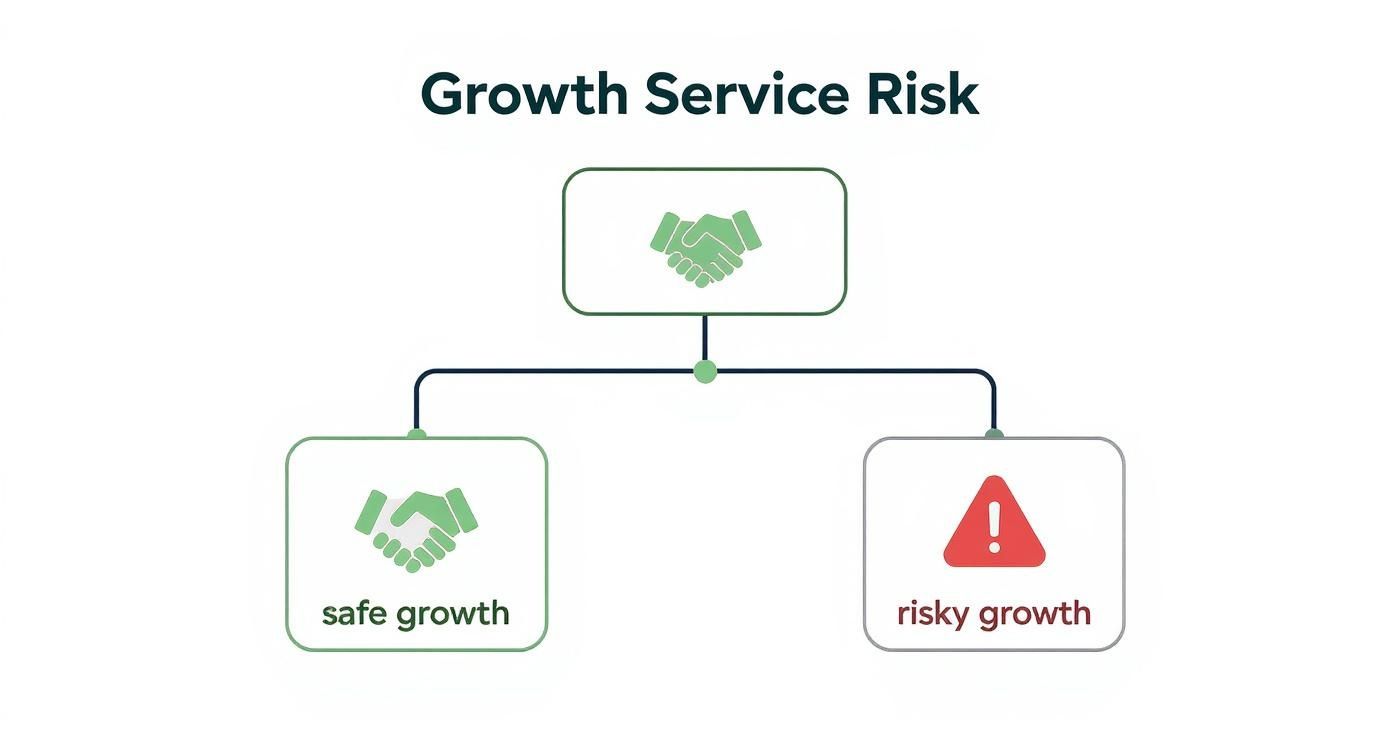
As you can see, the risky services promise lightning-fast results, but that path often leads straight to account penalties and dead engagement. The safe route, on the other hand, builds a sustainable, valuable asset for your brand over time.
Red Flags vs Green Flags When Choosing a Service
Knowing what to look for is half the battle. This table breaks down the common warning signs you should run from and the positive indicators that signal you've found a trustworthy partner.
| Red Flag Warning Sign | Green Flag Positive Sign |
|---|---|
| Guarantees a specific number of followers (e.g., "10k followers in 30 days"). | Focuses on activity metrics (e.g., "We'll engage with 200 accounts per day"). |
| Uses vague buzzwords like "proprietary methods" or "secret sauce" to hide their process. | Offers total transparency and is proud to explain their human-driven engagement strategy. |
| Their client portfolio has high follower counts but very low engagement (likes/comments). | Showcases case studies with strong engagement rates and tangible business results. |
| The pricing seems too good to be true (e.g., thousands of followers for under $100). | Pricing reflects the value of real human hours and strategic work. |
| They ask for your password immediately, without a clear security protocol. | They have a secure onboarding process and prioritize account safety. |
Ultimately, spotting the difference comes down to what they're selling. A bad service sells a number. A good one sells a process.
Critical Red Flags You Cannot Ignore
Just as important as asking the right questions is knowing when to walk away. Some red flags are so glaring that they should be immediate deal-breakers, no matter how good the sales pitch sounds.
Keep an eye out for these tell-tale signs:
- Unrealistic Guarantees: Any service promising "10,000 new followers in one week" is almost certainly using bots and fake accounts. Real, organic growth is a steady climb, not a rocket launch.
- Vague Strategy Descriptions: If they can't clearly explain how they get results and hide behind buzzwords like "AI-powered algorithms," they're likely masking risky automated tactics you don't want anywhere near your account.
- A Portfolio of Low-Engagement Clients: Do your own homework. Look up their current or past clients. If you find accounts with huge follower numbers but ghost-town engagement, that’s your proof they're delivering fake followers.
The Bottom Line: A trustworthy partner sells a process built on authentic engagement and targeted outreach. A risky provider sells an outcome—a specific number of followers—with zero regard for how they get there. Never sacrifice your brand's integrity for a vanity metric. Your reputation is worth far more.
Measuring Real Success Beyond Follower Counts
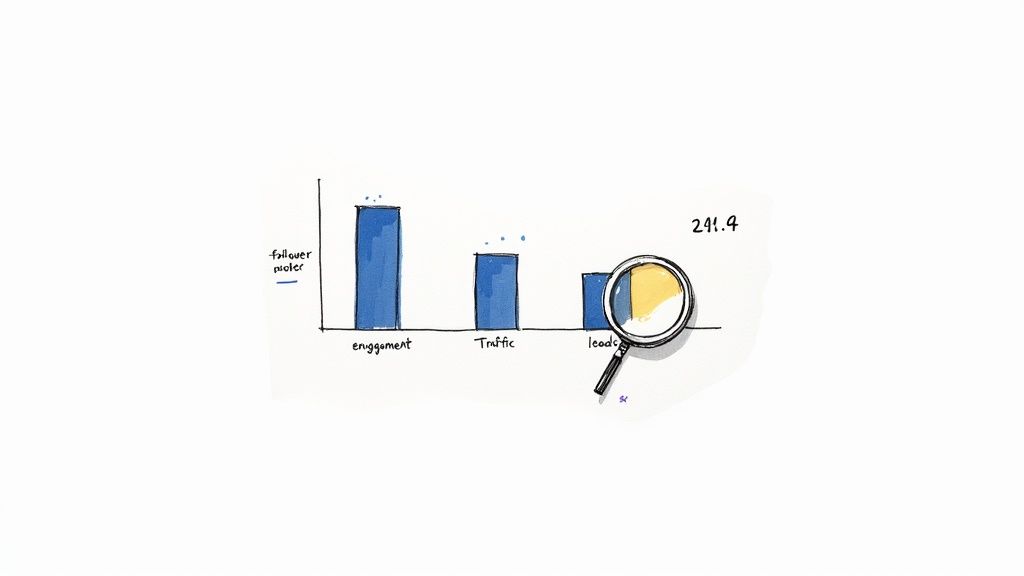
It’s easy to get mesmerized by a skyrocketing follower count. That number goes up, and you feel like you’re winning. But here’s the hard truth: if those new followers don't engage, click, or ever become customers, that big number is just a vanity metric. It’s a classic case of all sizzle and no steak.
To figure out if a social media growth service is actually delivering value, you have to shift your focus from raw numbers to tangible results. The real measure of success isn't just the size of your audience; it's the quality and action of that audience. You need to look past the surface and connect the dots between your social media activity and your core business goals.
Key Performance Indicators That Actually Matter
So, how do you see the real picture? By tracking the right Key Performance Indicators (KPIs). These are the metrics that tell the true story about your account’s health and whether the service is attracting the right kind of people. It's time to ditch the follower obsession and start paying attention to what counts.
- Engagement Rate Per Follower: Think of this as your account's pulse. A massive follower count with crickets in the comments section is a huge red flag. A healthy engagement rate is proof that your audience is real, listening, and genuinely interested in what you have to say.
- Audience Quality: Are these new followers even your potential customers? A solid growth service won't just bring you random accounts; they'll bring you the right accounts. You should be able to see in their reporting that your new followers match your ideal customer profile in terms of location, industry, and interests.
- Website Referral Traffic: One of the main goals of social media is to get people off the platform and onto your website. Keep an eye on your analytics. Are more visitors coming from your social profiles? A steady climb here means the service is attracting people who are curious enough to take the next step.
- Lead Generation and Sales: This is the bottom line. Are you seeing more demo requests, trial sign-ups, or sales that can be traced back to social media? This is the clearest sign of all that your investment is actually moving the needle for your business.
Getting a handle on these metrics is non-negotiable. For a deeper dive, check out our guide on how to measure social media engagement.
Calculating Your Return on Investment
Figuring out the ROI of a growth service is what separates a gut-feeling decision from a smart business one. It can be tricky to draw a straight line from a single "like" to a closed deal, but you can build a simple framework to see if it's paying off.
The best growth services get it. Their job isn't just to find you followers; it's to help you find customers. They align their entire strategy with your financial goals and provide reporting that clearly shows how they're contributing to your revenue.
Start by comparing the cost of the service to the value it generates. Let's say you spend $500 a month. If that investment brings in just three qualified leads, and each of those leads is worth $1,000 to your business, the math speaks for itself.
It's also smart to consider the context of each platform. While Facebook has a staggering number of users, people on YouTube often stick around much longer—an average of 49 minutes daily compared to Facebook's 32 minutes. Knowing little details like this helps you set realistic expectations for engagement and ROI on different channels. If you're curious about these nuances, sproutsocial.com has some great insights on social media demographics.
Ultimately, a partnership with a growth service is only successful if it drives measurable business results. Stay focused on these core metrics, and you'll know for sure that you're building a valuable asset, not just an empty number.
Frequently Asked Questions
Thinking about bringing in a social media growth service? You're not alone, but it's smart to have questions. This is where we cut through the noise and give you straight answers to the most common things SaaS founders, marketers, and agency owners ask. The goal here is to arm you with the info you need to decide if this is the right move for you.
We’ll cover everything from whether your account will be safe to what kind of followers you’ll actually get.
Are Social Media Growth Services Safe to Use?
This is the big one, and the answer is: it completely depends on how they do what they do. Your account's safety all comes down to whether the service uses real, human-powered strategies or risky, automated bots.
- Organic, human-driven services are generally safe. These services act like a real person on your team, manually engaging with others. This mimics natural behavior and plays by the rules of the platforms. It’s a strategy built for the long haul.
- Automated bot services are a gamble. They use software to blast out likes, follows, and comments at a scale that screams "not human." This is a direct violation of the terms of service for platforms like Instagram, X, and LinkedIn, putting your account at risk of being flagged, shadow-banned, or shut down for good.
Bottom line: Safety isn't a universal guarantee. It’s a direct result of the methods a company uses. If a provider isn't crystal clear about their process, that's a major red flag.
How Much Do These Services Typically Cost?
The price tag for a social media growth service can swing wildly, and that variation usually tells you a lot about the quality you're getting. You really do get what you pay for.
At the low end, you’ll find automated services for as cheap as $20 to $50 per month. They can offer these prices because it's all software—set it and forget it, with little to no real human thought involved.
On the other hand, premium organic growth agencies have actual people running your account. Their prices reflect that human expertise, typically ranging from a few hundred to over a thousand dollars a month. You’re paying for skilled strategists and community managers who are genuinely dedicated to your brand's growth.
Will I Get Real, Targeted Followers?
With a reputable, organic service? Absolutely. That's the whole point. Their entire game plan is to identify and connect with users who fit your ideal customer profile—based on their interests, demographics, and who they already follow. The followers you gain are real people who are likely to be interested in what you have to say.
Automated services are a completely different beast. Their goal is volume, not value. You might see your follower count shoot up, but it'll be a jumbled mix of bots, fake profiles, and users from halfway across the world who have no interest in your business. The numbers look impressive, but the engagement will be nonexistent.
Can I Stop the Service at Any Time?
Most credible growth services run on a simple monthly subscription. You can cancel whenever you want, no strings attached. No sneaky long-term contracts, just full control for you.
But what happens when you stop depends entirely on how you got your followers.
If you pause an organic service, you'll keep the authentic community you've built; you just won't be adding new followers through their efforts. If you cancel a bot-driven service, watch out. You’ll likely see a massive drop in followers as the platforms eventually purge all the fake accounts. Your engagement will also fall off a cliff the second the bots are turned off.
Ready to grow your brand's presence with authentic conversations, not risky bots? Replymer uses real human writers to find relevant discussions online and share your expertise, turning passive readers into active leads. See how our done-for-you service can build your brand on autopilot at https://replymer.com.
